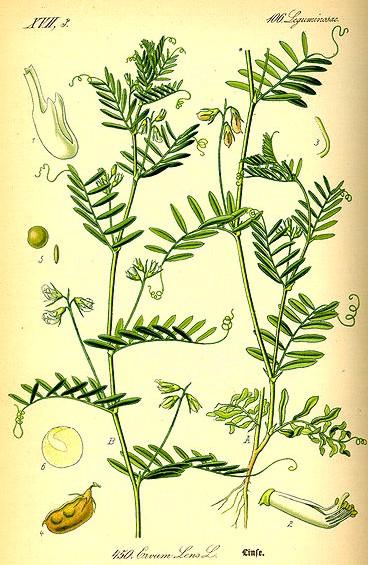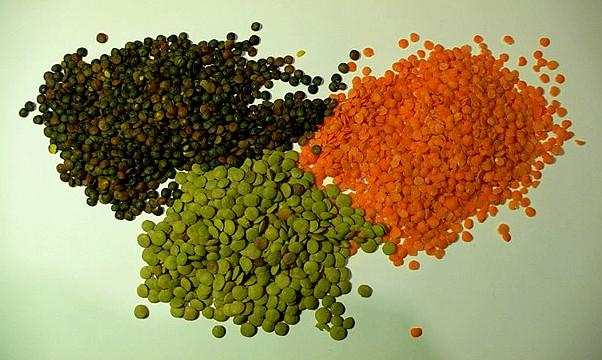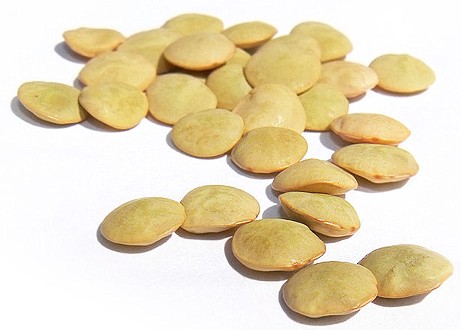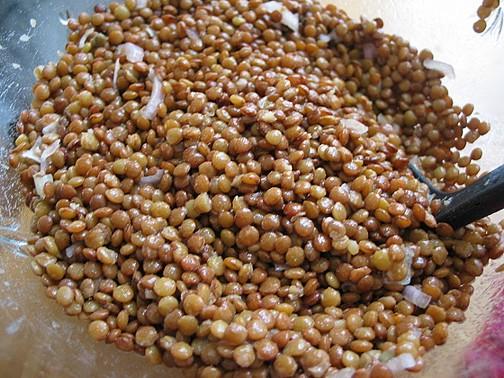Lessico
Lenticchia
Lens culinaris

La lenticchia, appartenente al genere Lens, Ŕ una leguminosa della famiglia Fabaceae nota sin dall'antichitÓ. ╚ una specie dicotiledone annuale, molto coltivata per le granelle commestibili, ricche di proteine. Diverse sono le varietÓ di lenticchie. I frutti sono dei baccelli che contengono due semi rotondi appiattiti. Le lenticchie fanno parte dei legumi secchi apprezzati in Europa anche se la produzione mondiale non Ŕ elevata: 3.841.883 t (2004). Come attesta l'episodio biblico di Esa¨, nella Genesi, il consumo delle lenticchie risale alla nascita dell'agricoltura in Mesopotamia. La specie culinaris - da cucina - comprende quattro sottospecie principali:
Lens
culinaris subsp. culinaris (lenticchia coltivata), qualche volta
considerata una specie distinta
Lens culinaris subsp. odemensis
Lens culinaris subsp. orientalis
Lens culinaris subsp. tomentosus.
La lenticchia Ŕ una pianta annuale erbacea, alta da 20 cm a 70 cm. Gli steli sono dritti e ramificati. Le sue foglie alterne, composte pennate, contano da 10 a 14 foglioline opposte, oblunghe e terminano con un viticcio generalmente semplice o bifido. Sono munite alla base di stipole dentate. I fiori, a corolla papilionacea tipica della sottofamiglia delle Faboideae, sono di color bianco o blu pallido e riuniti in grappoli da due a quattro. Il calice Ŕ regolare, a cinque denti sottili e relativamente lunghi. La fioritura estiva avviene tra maggio e luglio. I frutti sono dei baccelli appiattiti, corti, contenenti due semi dalla caratteristica forma a lente leggermente bombata. Il colore dei semi varia secondo le varietÓ dai pi¨ pallidi (verde chiaro, biondo, rosa) al pi¨ scuro (verde scuro, bruno, violaceo...).

Principali
varietÓ:
la lenticchia marrone, quella che si trova soprattutto in scatola;
la lenticchia rossa (gialla o arancia), utilizzata nella cucina asiatica;
le lenticchie verdi, come la lenticchia verde di Villalba e la lenticchia
verde di Altamura;
la lenticchia corallo o rosa, che Ŕ rossa ma sempre venduta sgusciata;
la lenticchia bionda, che Ŕ la pi¨ grossa;
la lenticchia rosa pallido come la lentillon rosÚ di Champagne (Francia).
Questa specie Ŕ originaria delle regioni temperate calde del mondo antico: Sud-Est dell'Europa: Cipro e Grecia - Asia Minore e Vicino Oriente: Turchia, Siria, Libano, Israele, Giordania, Iraq, Iran - Caucaso e Asia Centrale: Azerbaijan, Georgia, Kazakistan, Tagikistan, Turkmenistan, Uzbekistan, Afghanistan e Pakistan. La lenticchia Ŕ coltivata nel mondo intero, ma non cresce praticamente pi¨ allo stato selvaggio. In Italia, le varietÓ di lenticchie pi¨ diffuse sono:
Lenticchia
di Castelluccio di Norcia a Indicazione Geografica Protetta (I.G.P.) e a
Denominazione d'Origine Protetta (D.O.P.)
Lenticchia di Colfiorito prodotto agroalimentare tradizionale
Lenticchia di Santo Stefano di Sessanio prodotto agroalimentare tradizionale e
presidio di Slow Food.
Lenticchie
secche
Valori nutrizionali medi per 100 g di prodotto)
Energia KCal 330.00
Composizione chimica
Acqua 11.2 g
Proteine 28.00 g
Carboidrati 57.00 g
Grassi 1.2 g
Vitamine
Vitamina A (Retinolo) 25.00 mg
Tiamina (B1) 0.5 mg
Riboflavina (B2) 0.2 mg
Piridossina (B6) 0.5 mg
Acido Ascorbico (C) 6.2 mg
Niacina (PP) 2.6 mg
Minerali (mg)
Calcio 50.00
Ferro 9.00
Fosforo 450.00
Magnesio 100.00
Potassio 900.00
Sodio 10.00
Fibre 10,7 g
Le malattie da funghi che colpiscono la lenticchia sono l'antracnosi (Ascochyta pisi), la ruggine (Uromyces ervi), la peronospora (Peronospora viciae) e il marciume basale (Sclerotinia sclerotiorum). Tra gli insetti il pi¨ dannoso Ŕ il tonchio (Bruchus signaticornus).
Solo le lenticchie a buccia spessa devono essere tenute in ammollo prima di essere cucinate. Il tempo di cottura varia a seconda della varietÓ, quindi da pochi minuti a 40 minuti. Il sale Ŕ bene aggiungerlo a fine cottura.


The lentil or daal or dal (Lens culinaris), considered a type of pulse, is a bushy annual plant of the legume family, grown for its lens-shaped seeds. It is about 15 inches (38 cm) tall and the seeds grow in pods, usually with two seeds in each. The plant likely originated in the Near East, and has been part of the human diet since the aceramic (non-pottery producing) Neolithic times, being one of the first crops domesticated in the Near East. With approximately 26% of their calories from protein, lentils have the third-highest level of protein, by weight, of any plant-based food after soybeans and hemp, and is an important part of the diet in many parts of the world, especially in the Indian subcontinent which has large vegetarian populations.
A variety of lentils exists with colors that range from yellow to red-orange to green, brown and black. Red, white and yellow lentils are decorticated, i.e., they have their skins removed. There are large and small varieties of many lentils (e.g., Masoor Lentils). Lentils are sold in many forms, with or without the skins, whole or split. Culturally, other pulses are sometimes called lentils but are actually beans or peas, e.g. "black lentils" (urad beans).
The seeds have a short cooking time (especially for small varieties with the husk removed, such as the common red lentil) and a distinctive earthy flavor. Lentils are used to prepare an inexpensive and nutritious soup all over Europe and North and South America, sometimes combined with some form of chicken or pork. They are frequently combined with rice, which has a similar cooking time. A lentil and rice dish is referred to in the Middle East as mujaddara or mejadra. Rice and lentils are also cooked together in khichdi, a popular Indian dish. Lentils are used throughout India, the Mediterranean regions and the Middle East. In rare cases the lentils are mixed with dairy cheese.
A large percentage of Indians are vegetarian, and lentils have long been part of the indigenous diet as a common source of protein. Usually, lentils are boiled to a stew-like consistency with vegetables and then seasoned with a mixture of spices to make many side dishes such as sambar, rasam and dal, which are usually served over rice and roti.
When lentils are prepared, they are first inspected for damaged lentils, stones and other foreign matter. Then they are rinsed until the water runs through and comes out clear. Some prefer to soak the lentils for an extended time and discard the water. This removes substances that may cause indigestion.[dubious] The lentils are then boiled in water or broth. They may be cooked on the stovetop, or in a slow cooker. Pressure cookers are not recommended, since the small lentils may clog the pressure relief valve, and their quick cooking time means there is little benefit from pressure cooking. Cooked lentils often require thinning: adding more hot water or broth to the cooked legumes until the desired final consistency is reached.
Nutritional
value and health benefits
Lentils, raw (Dry Weight) Nutritional value per 100 g (3.5 oz)
Energy 350 kcal
Carbohydrates 60 g
Sugars 2 g
Dietary fiber 31 g
Fat 1 g
Protein 26 g
Thiamine (Vit. B1) 0.87 mg
67%
Iron 7.5 mg 60%
Lentils contain high levels of proteins, including the essential amino acids isoleucine and lysine, and are an essential source of inexpensive protein in many parts of the world for those who adhere to a vegetarian diet or cannot afford meat. Lentils are deficient in two essential amino acids, methionine and cystine. However, sprouted lentils contain sufficient levels of all essential amino acids, including methionine and cystine. Apart from a high level of proteins, lentils also contain dietary fiber, folate, vitamin B1, and minerals. Red (or pink) lentils contain a lower concentration of fiber than green lentils (11% rather than 31%). Health magazine has selected lentils as one of the five healthiest foods. Lentils are often mixed with grains, such as rice, which results in a complete protein dish.
Lentils are one of the best vegetable sources of iron. This makes them an important part of a vegetarian diet, and useful for preventing iron deficiency. Iron is particularly important for adolescents and pregnant women, whose requirements for it are increased.
Lentils are relatively tolerant to drought and are grown throughout the world. About half of the worldwide production of lentils is from India, most of which is consumed in the domestic market. Canada is the largest export producer of lentils in the world and Saskatchewan is the most important producing region in Canada. The Palouse Region of Eastern Washington and the Idaho Panhandle, with its commercial center at Pullman, WA, constitutes the most important producing region in the United States. FAO reports that world production of lentils for calendar year 2007 is 3.874 million metric tonnes, primarily coming from India (36%), Canada (17%) and Turkey (15%). National Agricultural Statistics Service (NASS) reports United States 2007 production at 154.5 thousand metric tonnes, primarily coming from North Dakota, Montana, Washington, and Idaho.